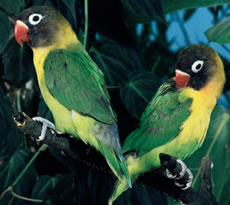Description and biology
Lovebirds are small African parrots. The black–cheeked lovebird is perhaps the most threatened of all lovebird species in the wild. This bird is primarily green, with a black face and cheeks and a white eye–ring. Its forehead is dusky–red. It feeds mainly on seeds, grass seeds, and leaves. Breeding takes place in November and December.
Habitat and current distribution
The black–cheeked lovebird is confined mainly to the extreme southwestern part of Zambia. Outside of Zambia, it is found along the Zambezi River in northern Zimbabwe, at the very northernmost tip of Botswana, and at the eastern tip of the Caprivi Strip in Namibia.
The total number of these lovebirds currently in existence is unknown, though it has been estimated that there are less than 10,000 in the wild.
The bird prefers to inhabit medium–altitude forests dominated by deciduous (shedding) trees. The total habitat range is about 2,300 square miles (5,960 square kilometers).
History and conservation measures
In the twentieth century, black–cheeked lovebirds have been trapped and sold around the world as caged pets. During a four–week period in 1929, as many as 16,000 of the birds were captured. The species has never recovered from this assault.
Despite legal protection in Zambia, this lovebird is still trapped illegally. It remains a common cage bird. Another threat to the black–cheeked lovebird is the draining of water sources in its habitat to supply agricultural needs. The destruction of its habitat to create farmland also remains a potential threat.
Black–cheeked lovebirds have become better established in captivity. Although the captive–bred population is still relatively small, it has grown steadily over the last twenty years.

